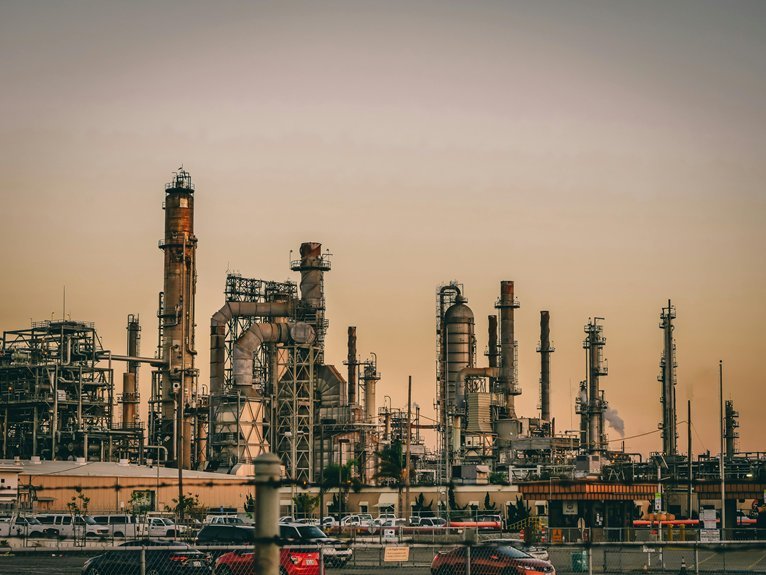
When considering generators, you face a choice between dual fuel and single fuel models. Dual fuel generators offer flexibility by using both propane and gasoline, while single fuel models stick to one type. You might wonder about efficiency, emissions, costs, and even practicality for your needs. Choosing the right generator could impact your power reliability and expenses. What are the key factors that should influence your decision?
Fuel Type and Usage Considerations
When choosing between dual fuel and single fuel generators, it is crucial to evaluate fuel type and usage. Dual fuel generators offer significant fuel type versatility, operating on both propane and gasoline. This allows you to switch fuels based on availability, providing flexibility during shortages or price spikes. Propane’s indefinite shelf life further enhances fuel usage flexibility, unlike gasoline’s limited 6-12 month storage duration. In contrast, single fuel generators rely on one fuel type, like gasoline or diesel, which can limit your options during supply disruptions. Dual fuel systems also simplify extended operation by seamlessly switching fuels without manual intervention. This reduces downtime and guarantees continuous power, making dual fuel generators a practical choice for those seeking adaptability.
Efficiency and Emission Comparisons
After evaluating fuel type and usage, it’s important to contemplate the efficiency and emissions of dual fuel versus single fuel generators. Dual fuel generators typically achieve around 90% operating efficiency, considerably higher than the 70-80% of single-fuel models. This superior engine performance stems from the ability to blend or switch fuels, optimizing combustion efficiency. Using propane in dual fuel systems not only enhances fuel economy but also reduces emissions by about 12% compared to gasoline or diesel. These generators emit less carbon monoxide and particulate matter, making them environmentally friendlier. In contrast, single-fuel generators, particularly diesel, lack such flexibility, often resulting in higher emissions and lower efficiency. Choosing a dual fuel generator can therefore improve both performance and environmental impact.
Cost and Maintenance Factors
While dual fuel generators offer significant advantages, they come with distinct cost and maintenance factors to evaluate. The initial investment is 15-30% higher than single-fuel models, but this cost is offset by long-term savings from fuel flexibility and enhanced features. Financing options can ease the upfront financial burden.
Maintenance complexity is a factor to assess, as dual fuel systems involve additional components that may require more upkeep. Annual maintenance costs are slightly higher, typically ranging $50-100 more than single-fuel units. The complexity stems from managing separate fuel systems, which can lead to regulator or valve issues. Despite these challenges, dual fuel generators retain strong resale value due to their versatility and market demand, making them a worthwhile investment.
Fuel Storage and Shelf Life Insights
As you consider the cost and maintenance of dual fuel generators, it’s important to also think about fuel storage and shelf life. Choosing the right fuel container type is vital. Diesel can be stored in underground or above-ground tanks. While underground tanks save space, they require complex installation and constant monitoring. Above-ground tanks, especially double-wall ones, offer built-in secondary containment, reducing environmental risks. Propane has a long shelf life in sealed tanks, while gasoline’s shorter shelf life demands stabilizers. Diesel and propane benefit from proper storage conditions, extending their usability. Implementing fuel monitoring systems guarantees your fuel remains safe and stable, helping you avoid costly issues. Remember, maintaining compliance with safety standards is essential for peace of mind.
Portability and Application Suitability
Considering the dual fuel generator’s appeal, you should weigh its portability and application suitability against a single fuel option. Dual fuel generators usually have a heftier weight distribution, making them less portable. They often include wheels and handles to offset this, but the need to tether to a propane tank can complicate transport. In contrast, single fuel generators are lighter and easier to move, making them ideal for quick transportation and setup.
When it comes to application suitability, dual fuel generators excel in emergency readiness, providing flexibility by switching between propane and gasoline. They handle high power output needs and adapt to varying fuel availability. However, single fuel generators boast simpler mechanics, resulting in easier maintenance and lower repair costs.
